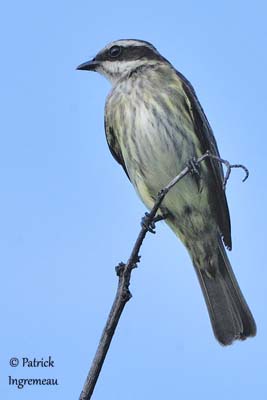
Text by Nicole Bouglouan
Photographers:
Didier Buysse
Vision d’Oiseaux
Marc Chrétien
MURINUS
Alfredo Colón
Puerto Rico Wildlife
Maxime Dechelle
LEPAPARRAZO
Jean Michel Fenerole
Photos d’Oiseaux du monde
Steve Garvie
RAINBIRDER Photo galleries
Tom Grey
Tom Grey's Bird Pictures
Patrick Ingremeau
TAMANDUA
Eduardo Andrés Jordan
MIS AVES – AVES DE ARGENTINA
René Lortie
http://rlortie.ca/
Tom Merigan
Tom Merigan’s Photo Galleries
Bob Moul
Nature Photography
Pete Moulton
Pete Moulton Photography
Philippe et Aline Wolfer
OISEAUX D'ARGENTINE
Sources:
HANDBOOK OF THE BIRDS OF THE WORLD Vol 9 - by Josep del Hoyo - Andrew Elliot - David Christie - Lynx Edicions - ISBN: 8487334695
A GUIDE TO THE BIRDS OF MEXICO AND NORTHERN CENTRAL AMERICA by Steve N. G. Howell, Sophie Webb - Oxford University Press - ISBN: 0198540124
A GUIDE TO THE BIRDS OF COLOMBIA by Steven L. Hilty and William L. Brown - Princeton University Press – ISBN 069108372X
BIRDS OF THE GREAT BASIN – by Fred A. Ryser - Univ of Nevada Pr -ISBN: 0874170796
FIELD GUIDE TO THE BIRDS OF NORTH AMERICA - National Geographic Society - ISBN: 0792274512
PORTRAITS D’OISEAUX GUYANAIS - Groupe d'étude et de protection des oiseaux en Guyane (GEPOG) - Ibis rouge éditions - ISBN: 2844501842
TYRANNIDAE FAMILY
Tyrants-Flycatchers
Subfamily Tyranninae
The subfamily Tyranninae is more uniform than the preceding two. The physical characters are rather similar and several species appear almost identical.
These are medium-sized to large flycatchers with large head. Two Tyrannus species show elongated “scissor” tails, but their bodies have the typical proportions of this group.
Among this subfamily, the tendency is to frequent open habitats and forest edges, from desert to rainforest. Only some species are living deep inside the tropical forest.
Many of them are migratory, and are now established in the West Indies too, but most of them have wide range extending from the USA or N Mexico, S to Central and South America, including in the southern regions.
The subfamily Tyranninae is divided into two tribes, Tyrannini and Attilini.
The group Tyrannini contains the kingbirds (Tyrannus) and their allies, with species and genera showing bright yellow belly, olive or brownish back, conspicuous head pattern of grey or black with white stripes, and a semi-concealed crown patch only visible when the feathers are raised during aggressive or courtship displays. This patch can be yellow, orange or red.
The group Attilini includes the widespread genus Myiarchus, and several smaller, strictly tropical genera.
Group Tyrannini
The first genus Legatus with the Piratic Flycatcher (Legatus leucophaius), is highly frugivorous all year round. It often sits for long time above the colonies of Icteridae species while calling, and sometimes flies off to fruiting trees before to return to its perch. This species may appropriate the nests of large Icteridae.
It is highly migratory, and moves into equatorial latitudes from both ends of its range, according to the fruit availability.

The flycatchers of genus Myiozetetes are conspicuous in the tropical open-country habitats from Central America, S to Bolivia and Argentina. They often live close to human habitations. They are mainly frugivorous and feed at fruiting trees with other birds’ species along forest edges.
The Social Flycatcher (Myiozetetes similis) is the most conspicuous and widespread. This species does not live in social groups in spite of its name, but the pairs often nest close to each other.
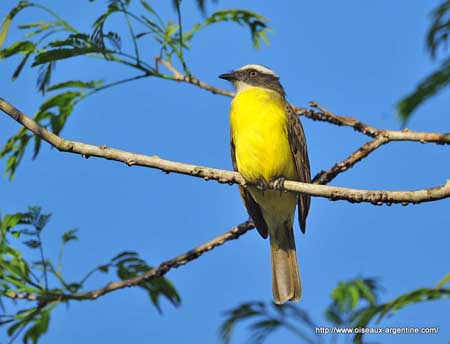
The rarest and the smallest in this genus is the Dusky-chested Flycatcher (Myiozetetes luteiventris). It lacks the white supercilium and has smaller bill and feet. It occurs across the Amazon lowlands.
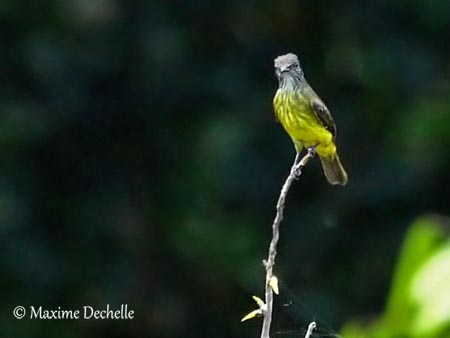
Dusky-chested Flycatcher
Myiozetetes luteiventris
The two other species of this genus, the Grey-capped Flycatcher and the Rusty-margined Flycatcher, feeds on fruits and insects, foraging in shrubby areas, clearings and cultivated fields.
As all members of genus Myiozetetes, they build a bulky, domed nest with a side entrance.
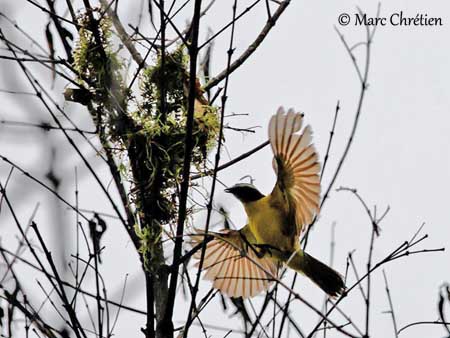
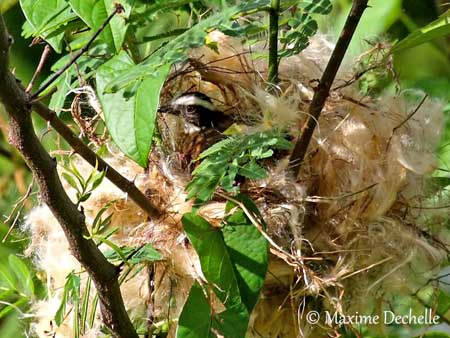
Rusty-margined Flycatcher
Myiozetetes cayanensis
The only member of the genus Phelpsia, the White-bearded Flycatcher (Phelpsia inornata) differs from the other kingbirds by internal morphological features.
It builds a large cup-shaped nest covered with lichens bound together by spiderwebs and placed on a horizontal branch.
The Great Kiskadee (Pitangus sulphuratus) has robust body proportions, a large, slightly hooked bill and strong legs and feet.
Its voice is the most raucous and loud of the entire family. As well by physical characters as by its voice, the Great Kiskadee exhibits some convergences with jays.
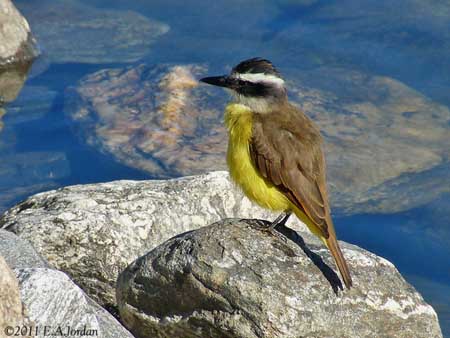
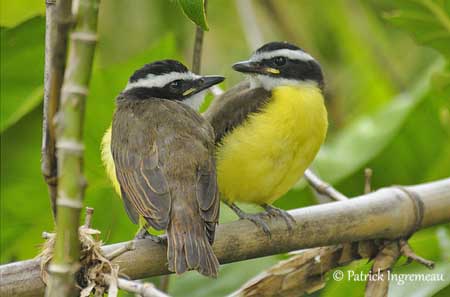
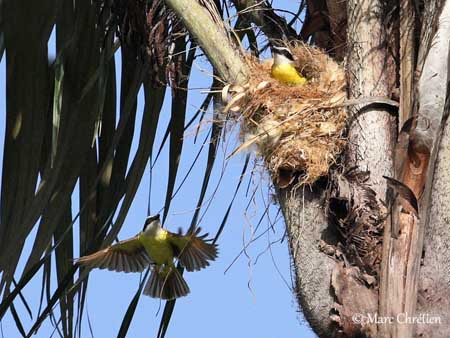
Unlike the Great Kiskadee, the Lesser Kiskadee (Philohydor lector) is more secretive. It frequents the grassy and brushy margins of slow-moving waters. It utter soft, guttural mew.
The nest is different too. This is a saucer-shaped cup made with twigs and vines.
For these reasons, and in spite of physical resemblance, the Lesser Kiskadee has its own genus.
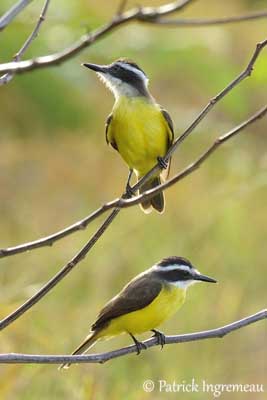
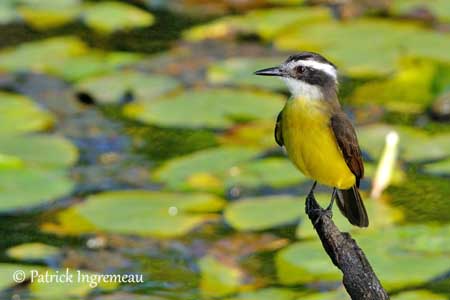
The following two genera are closely related to kingbirds, but they are cavity-nesters.
The genus Conopias includes four small flycatchers very similar to Myiozetetes, but they frequent mainly small openings within more forested habitats.
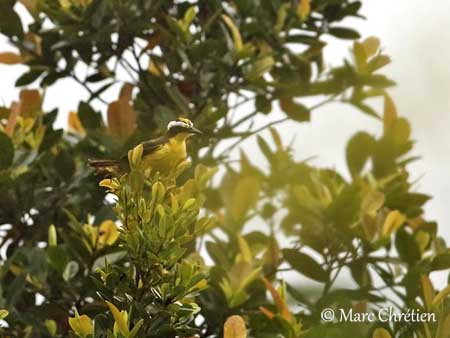
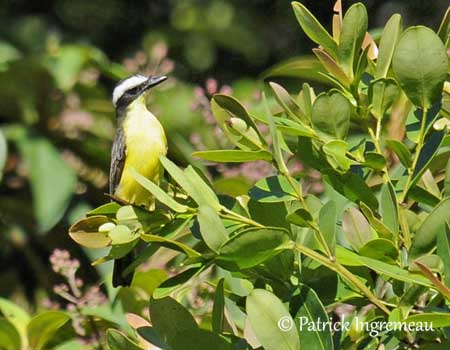
The genus Myiodynastes contains five species with large body and bill. They cover most of the range of plumage diversity found among the kingbird group.
These birds forage in open forest canopy and understorey. They catch large insects from leaves, air or ground. Outside the breeding season, they feed mainly on fruits.
They have wide range from Mexico, through Central America S to Argentina.
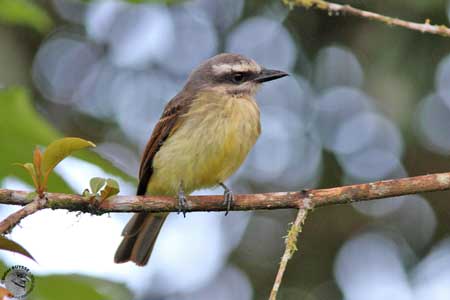
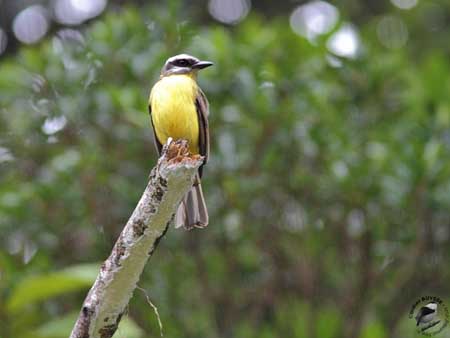
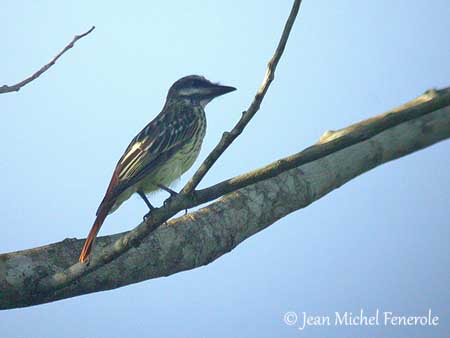
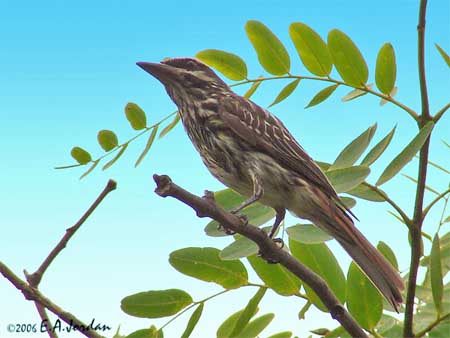
The largest bill of any Tyrannidae species is that of the Boat-billed Flycatcher (Megarynchus pitangua).
Body form and plumage are similar to those of the Great Kiskadee. This species occurs in tropical forest and edges. It is found high in trees from where it snatches large preys such as moths, arboreal snakes and lizards. Most of preys are taken from the underside of the leaves.
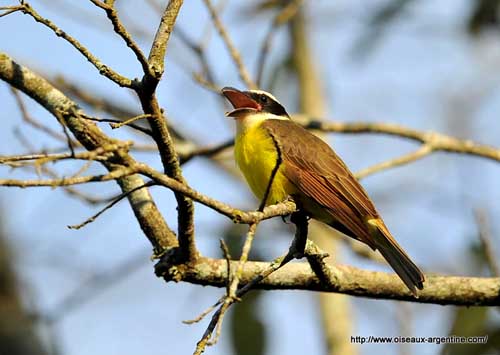
This bird is relatively large with a length of 22-24 centimetres and a weight of 62-70 grams. The nest is a rounded shallow cup made with a variety of plant materials, placed between 6 and 30 metres up in fork of horizontal branch.
This species occurs from E, W and S Mexico, through Central America to northern half of South America. It is adaptable to several types of habitats.
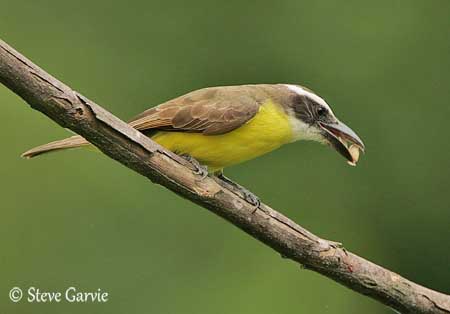
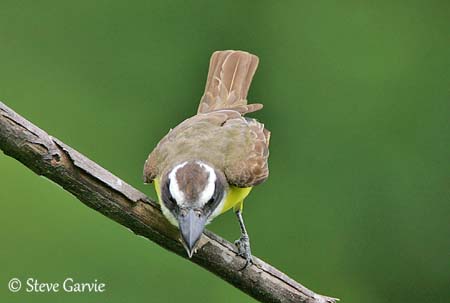
The Sulphury Flycatcher (Tyrannopsis sulphurea) is poorly known. It is found in the Amazon and southern forests. Very similar to kingbirds, this species might be included within the genus Tyrannus next day.
However, it differs in both internal and external characters. It has very short, squared tail, short legs, short and broad bill. This species often occurs in Mauritia palms.
Sulphury Flycatcher
Tyrannopsis sulphurea
The two following genera are highly migratory.
The Variegated Flycatcher (Empidonomus varius) resembles smaller Piratic and largest Streaked Flycatchers, but it differs by rusty rump and tail.
It migrates from S Brazil and Argentina northwards to the llanos of Venezuela.
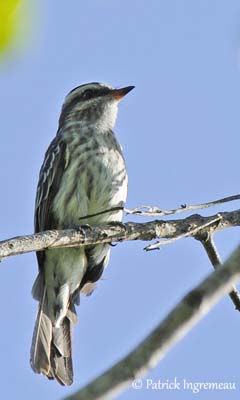
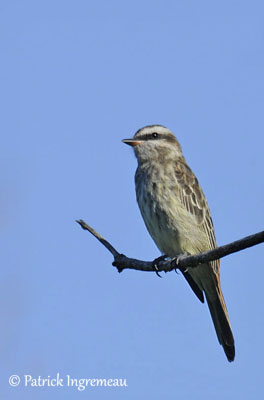
The Crowned Slaty Flycatcher (Griseotyrannus aurantioatrocristatus) has very distinctive slate-grey plumage, black crown and concealed gold crown patch.
This one performs northwards movements after the breeding season.
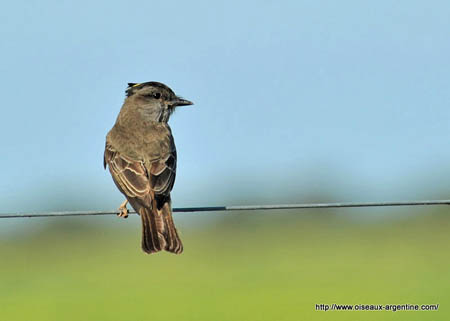
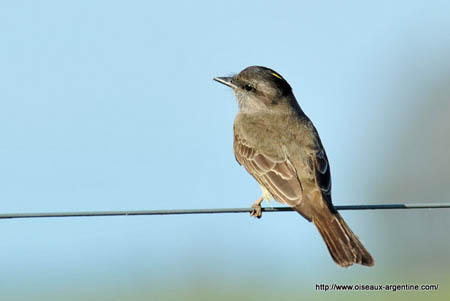
Both species are found at treetops from where they perform aerial sallies for flying insects, but they also feed on fruit.
The flycatchers of the genus Tyrannus are the most widespread and familiar group in the New World.
They are named “Kingbirds” in English for the conspicuous crown feathers giving them distinct rear-crested profile. These feathers are raised during the displays, revealing red, orange or yellow crown patch.
Two different species belongs now to this genus, but they were formerly in their own genus Muscivora.
The Scissor-tailed Flycatcher and the Fork-tailed Flycatcher have an exceptionally long, forked tail. But several internal, behavioural and genetic characters prove they are kingbirds.
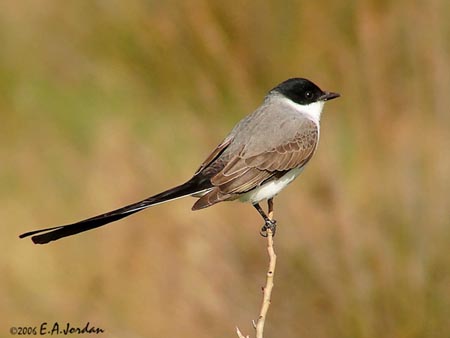
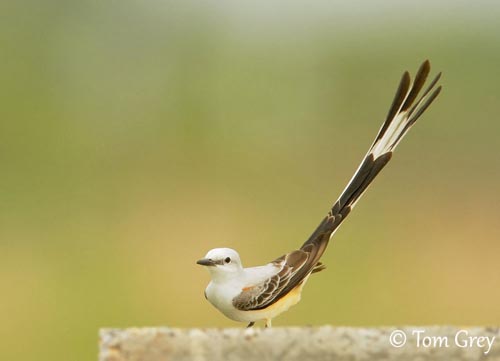
All members of genus Tyrannus are aerial hawkers and frequent open country and woodland, and also forest edges. They often sit on prominent perch from which they perform aerial sallies.
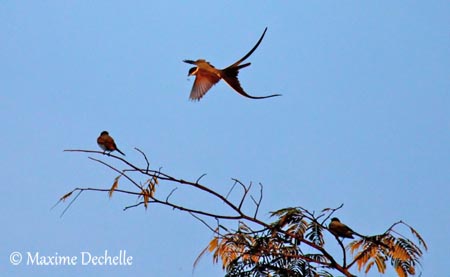
Fork-tailed Flycatcher
Tyrannus savana
They have long, pointed wings and forked tail, allowing them easier and powerful aerial sallies, and their agile flight help them to pursue their preys in the air.
Many kingbirds are highly migratory.
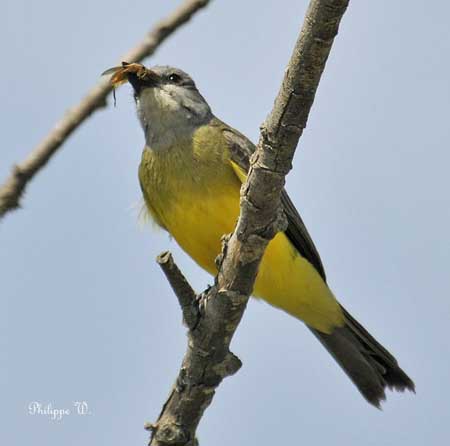
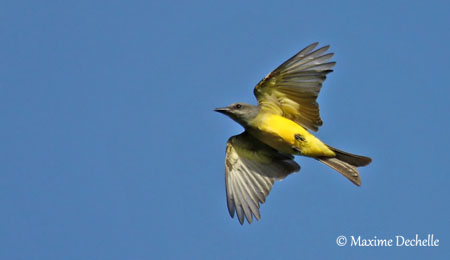
Tyrannus melancholicus
The genus Tyrannus is present from N Canada, S to southern Argentina and throughout West Indies. They are one of the few Tyrannidae species to have a centre of radiation in W North America.
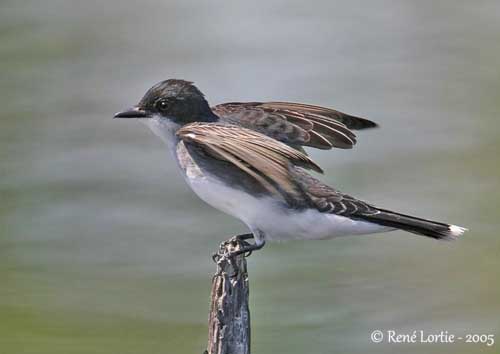
Tyrannus tyrannus
A few species such as the Giant Kingbird (Tyrannus cubensis) and the Grey Kingbird ( Tyrannus dominicensis) are restricted to the West Indies.
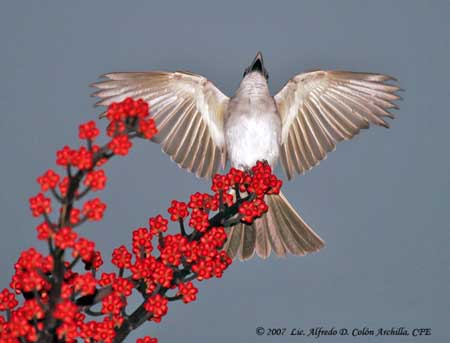
But we can also find the Loggerhead Kingbird ( Tyrannus caudifasciatus) which is resident from Bahamas, Cuba, Cayman Is, Jamaica, Hispaniola and Puerto Rico.
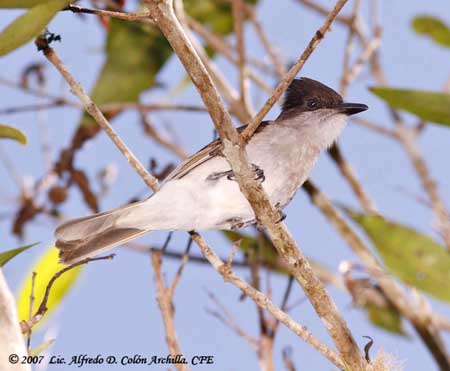
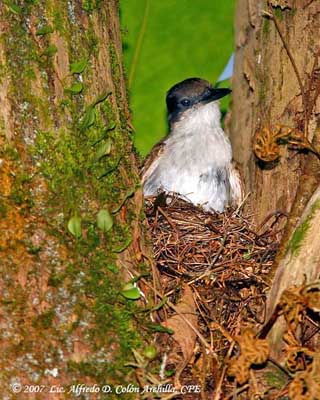
Only two species are restricted to South America. The Snowy-throated Kingbird (Tyrannus niveigularis) of the Pacific lowlands and the White-throated Kingbird (Tyrannus albogularis) found in grassland from Venezuela to S Brazil.
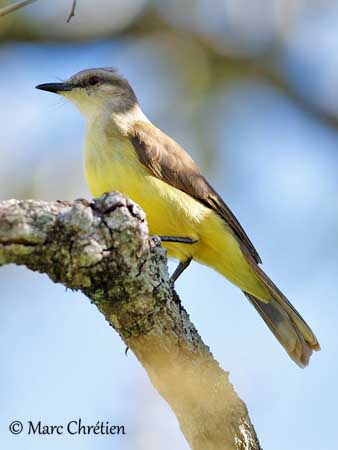
White-throated Kingbird
Tyrannus albogularis
These birds are able to catch larger preys than other Tyrannidae species, thanks to their larger size and bill. Their nests are usually cup-shaped and placed in forks in trees. They are made with several plant materials. The displays are often aerial with both mates flying and calling together. The crest feathers are raised during the displays.
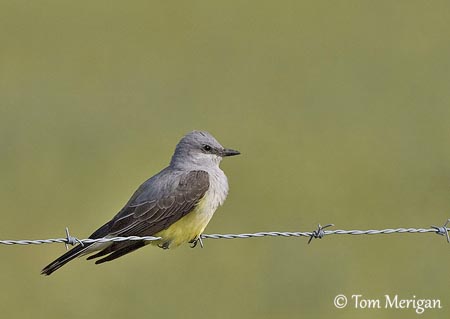
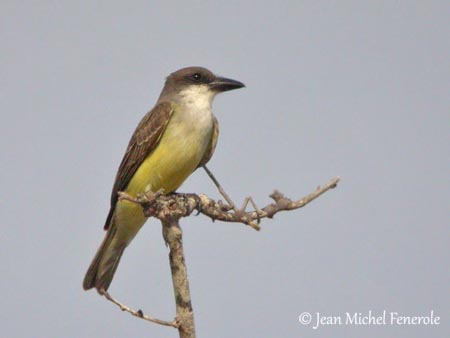
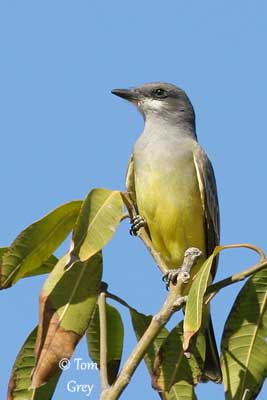
Cassin's Kingbird
Tyrannus vociferans
Group Attilini
The eight genera of the tribe Attilini are slightly different from the preceding ones.
Some anatomical and behavioural evidence occur between Rhytipterna, Sirystes and Casiornis, and the larger genus Myiarchus.
Formerly, Casiornis, Rhytipterna and Attila were classified as Cotingidae species, and excluded from Tyrannidae due to morphological difference in tarsi.
They frequent forest and woodland, and perch for long periods before to perform sallies to snatch large preys in the mid-storey and the subcanopy. They often follow mixed-species foraging flocks.
The Pale-bellied Mourner (Rhytipterna immunda) seems to be widespread in scrubby woodland within the Amazon Basin where it utters its peculiar dawn song.
In the same way, the Greyish Mourner (Rhytipterna simplex) can be seen alone, in pair or in small group, often accompanying mixed flocks. It makes sudden sallies from perch and gleans from foliage and branches while hovering.
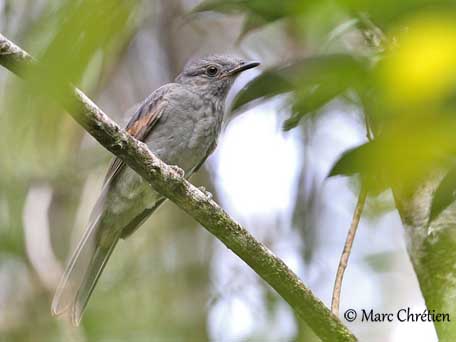
The only member of the genus Sirystes, the Sirystes (Sirystes sibilator) is a highly distinctive black-and-white bird with hole-nesting habits. This species is an interior-forest genus. It breeds in hole created from branch breakage and not excavated.
It is mostly resident in its range in the northern half of South America, with some movements in extreme S Brazil.
The Sirystes is more often heard than seen. Its ringing call allows locating it in the highest part of the forest canopy where it spends most of the time.
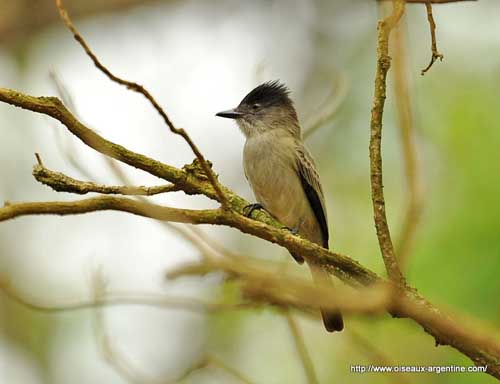
Sirystes
Sirystes sibilator
The two species of the genus Casiornis are considered to be allied with the following genus Myiarchus.
The Rufous Casiornis (Casiornis rufus) and the Ash-throated Casiornis (Casiornis fuscus) occur in woodland habitats.
The Rufous Casiornis ranges in the centre of the northern half of South America, whereas the Ash-throated Casiornis occurs in NE Brazil S of Amazon.
Both species hunt from perch, with the crown feathers often raised. Their behaviour is poorly known, but some observations suggest cavity-nesting habits. They are probably resident.
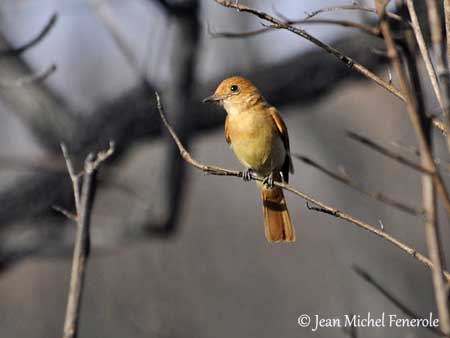
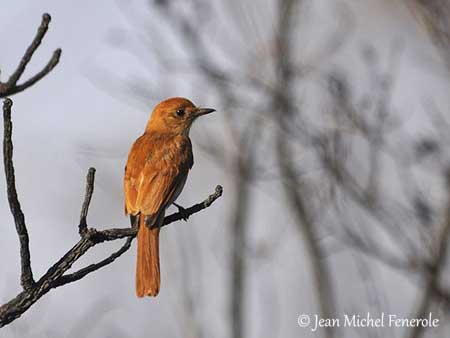
The genus Myiarchus includes the most widespread of all Tyrannidae species.
Both Great-crested Flycatcher (Myiarchus crinitus) and Ash-throated Flycatcher (Myiarchus cinerascens) breed in North America
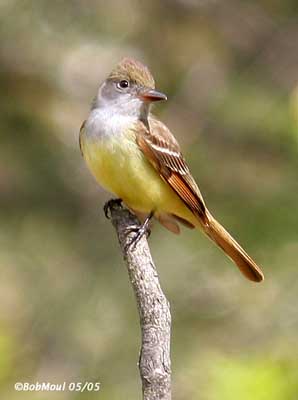
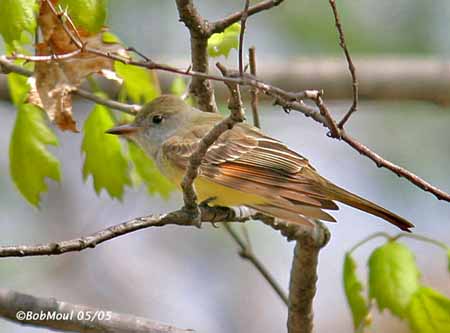
On the other hand, the Brown-crested Flycatcher (Myiarchus tyrannulus) and the Dusky-capped Flycatcher (Myiarchus tuberculifer) have a very broad distribution from SW USA, S to Bolivia and Argentina.
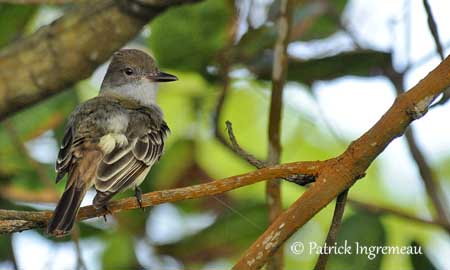
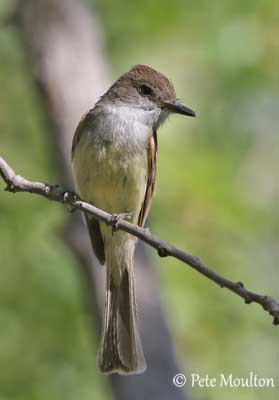
Dusky-capped Flycatcher - Myiarchus tuberculifer
Six species are living in the West Indies, and are an important Tyrannidae radiation among the Caribbean Islands.
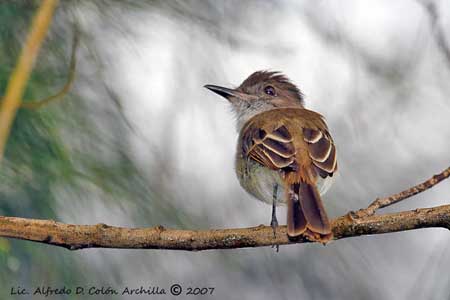
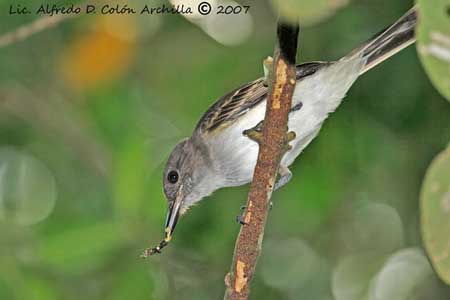
The Galapagos Flycatcher (Myiarchus magnirostris) reached these islands and is now becoming more terrestrial little by little as it performs frequent sallies to the ground for insects.
Several species had been “hiding” within other groups, and were revealed only thanks to their voice.
The locally distributed Panama Flycatcher (Myiarchus panamensis) and the Venezuelan Flycatcher (Myiarchus venezuelensis) had been considered as races of the Short-crested Flycatcher (Myiarchus ferox) which has very different vocal repertoire.
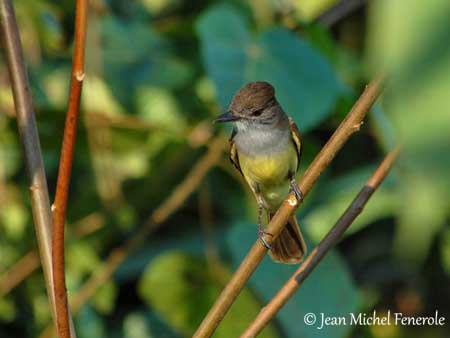
Short-crested Flycatcher
Myiarchus ferox
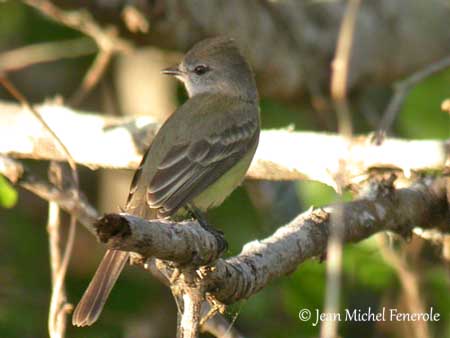
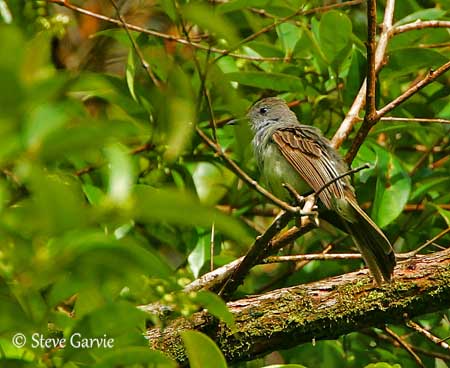
All the members of the genus Myiarchus build the nest inside natural or man-made cavities. They often use pieces of snake and lizard skin and hair from mammals as lining.
All members of group Attilini have this peculiar nesting behaviour.
The Flammulated Flycatcher (Deltarhynchus flammulatus) also nests in holes and for this reason, it is considered another member of Myiarchus assemblage.
This species occurs in narrow Pacific coastal band in SW and S Mexico. It frequents dry areas such as deciduous thickets, thorny open woodland with mesquites and acacias, semi-arid forest and scrubby woodland.
However, this species is placed in its own genus because some internal characters and its plumage pattern make it different from Myiarchus. It has slightly streaked underparts and two pale wing bars.
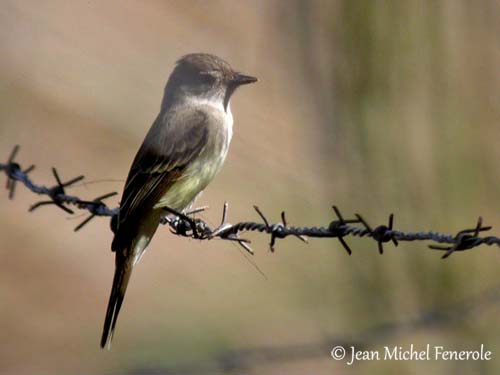
Flammulated Flycatcher
Deltarhynchus flammulatus
On the other hand, it is related to the South American genus Ramphotrigon which is also a cavity nester related to Myiarchus.
Ramphotrigon is restricted to Amazonia. It hunts mainly by upward-strike foraging behaviour. It has loud dawn songs, but during the day, the song it utters plaintive whistles.
There are three species in this genus. They usually frequent humid habitats such as seasonally flooded forest and thickets, floodplain and swamp forest. All are cavity nesters.
The genus Attila is a group of seven large-bodied tropical species (18-22 cm length) with behaviour and general appearance similar to Myiarchus assemblage. These birds also nest in cavities.
They are powerful birds which frequent the middle storey in tropical forest and deciduous woodland.
They have strong, hooked bill, almost similar to that of high-Andean shrike-tyrants, and in the same way, they often attack very large preys such as large spiders, huge caterpillars, and arboreal snakes, lizards and frogs.
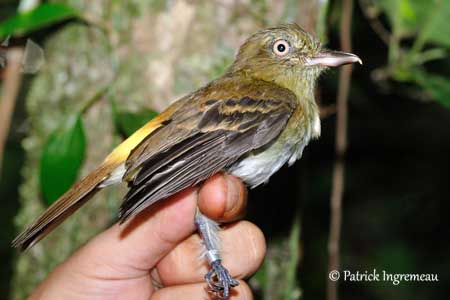
Bright-rumped Attila
Attila spadiceus
The Bright-rumped Attila (Attila spadiceus) occurs from S Mexico S through Amazonia. Its ringing song is very distinctive.
This species has several distinct colour morphs such as bright rufous, dark olive and olive-grey, with contrasting yellow rump and yellowish belly.
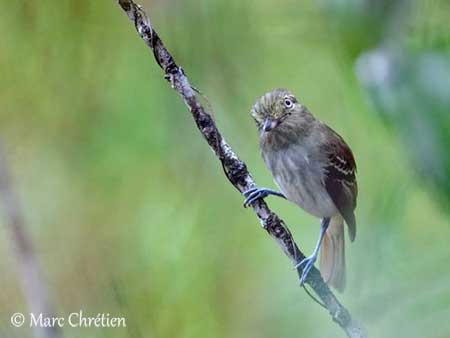
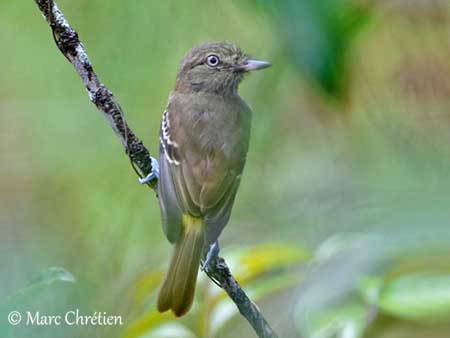
The Cinnamon Attila (Attila cinnamomeus) occurs in the entire Amazon-Orinoco Basin. It is usually found in wet areas and near water.
It feeds on large preys, perching quietly before to perform short-distance sallies, or fluttering in front of the foliage to glean prey items.
The nest is an open cup placed in bark crevice in tree trunk. It is made with small dead sticks and lined with rootlets.
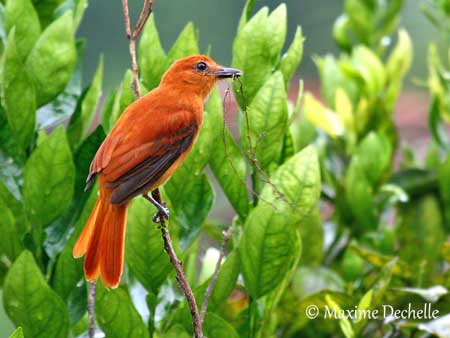
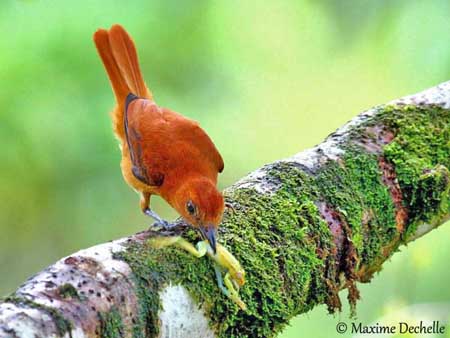
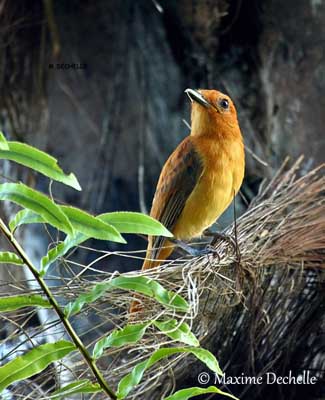
Cinnamon Attila
Attila cinnamomeus
The latest genus within the group Attilini is moving back and forth between Cotingidae and Tyrannidae.
One of the two members of genus Laniocera builds a messy, cup-shaped nest, excluding it from the Myiarchus assemblage.
Several internal anatomical characters make this genus related to the primitive Tyrannidae, but due to this ambiguous relationship, Laniocera does not belong in the family Tyrannidae. However, it is currently placed in it in the absence of sufficient information.
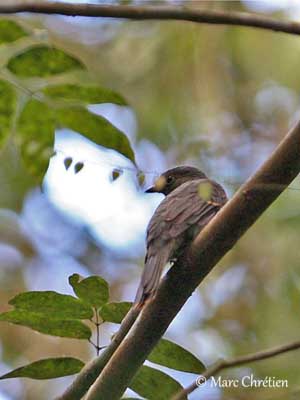
Cinereous Mourner
Laniocera hypopyrra